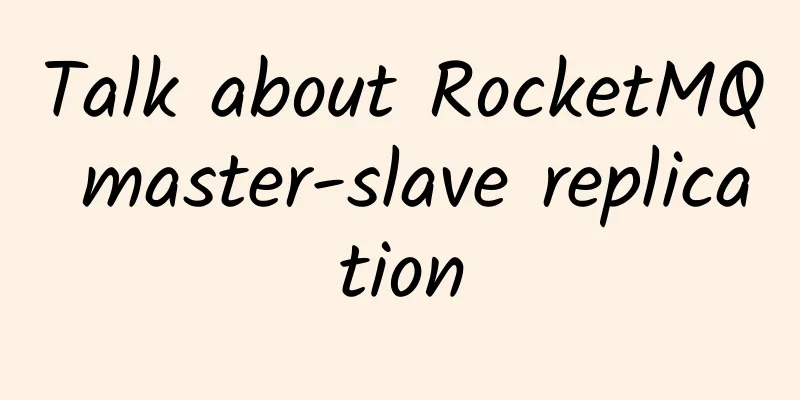Talk about RocketMQ master-slave replication

|
RocketMQ master-slave replication is one of RocketMQ's high availability mechanisms. Data can be replicated from the master node to one or more slave nodes. In this article, we will talk about RocketMQ's master-slave replication. I hope that after reading this article, you will be able to understand the essence of master-slave replication. picture 1. Synchronous and asynchronousIn RocketMQ's cluster mode, Broker is divided into Master and Slave. A Master can correspond to multiple Slaves, but a Slave can only correspond to one Master. Each Broker establishes a persistent connection with all nodes in the Name Server cluster and periodically registers Topic information to all Name Servers. picture The Master node is responsible for receiving write requests from clients and persisting messages to disk, while the Slave node is responsible for copying message data from the Master node and keeping it synchronized with the Master node. 1. Synchronous replicationpicture Each Master is configured with a Slave, and there are multiple Master-Slave pairs. HA uses a synchronous dual-write method, that is, only when both the master and the slave are written successfully, will success be returned to the application. The advantages and disadvantages of this model are as follows:
2. Asynchronous replicationpicture Each Master is configured with a Slave, and there are multiple Master-Slave pairs. HA uses asynchronous replication, and there is a short message delay (millisecond level) between the master and the slave. The advantages and disadvantages of this mode are as follows:
The replication process is divided into two parts: metadata replication and message data replication.
2. Metadata ReplicationThe Slave Broker scheduled task synchronizes metadata every 10 seconds, including topics, consumption progress, delayed consumption progress, and consumer configuration. picture When synchronizing a topic, the Slave Broker sends an RPC request to the Master Broker. After the data is returned, it is first added to the local cache and then persisted locally. picture 3. Message Data ReplicationThe figure below is a flowchart of Master and Slave message data synchronization. picture 1. After the Master is started, it listens to the specified port;After the Master is started, it creates the AcceptSocketService service to create a TCP link from the client to the server. picture RocketMQ abstracts the connection object HAConnection. HAConnection starts two threads, one for read service and one for write service:
picture 2. After the Slave is started, it tries to connect to the Master and establish a TCP connection;HAClient is the core class of the client Slave, responsible for establishing connections and data interaction with the Master. picture After starting, the client first tries to connect to the Master, queries the maximum physical offset in the current message storage, and stores it in the variable currentReportedOffset. 3. Slave reports the offset of the pulled message to the Master;picture The data format for reporting progress is a Long type Offset, 8 bytes, which is very concise. picture After sending to the Socket buffer, modify the last write time lastWriteTimestamp. 4. The Master parses the request offset and retrieves all messages after the offset from the message file;When the Slave reports data to the Master, the SelectionKey.OP_READ event is triggered, and the Master passes the request to the ReadSocketService service for processing: picture When the Slave Broker passes the maxPhyOffset of its own commitlog, the Master will immediately interrupt selector.select(1000) and execute the processReadEvent method. picture The core logic of the processReadEvent method is to set the current progress offset of the Slave and then notify the replication thread of the current replication progress. The write service WriteSocketService retrieves all messages after the offset from the message file (limited by the size of the transmission batch data) and sends the message data to the Slave. picture 5. The slave receives the data and appends the message data to the message file commitlog.picture First, the dispatchReadRequest method is called in the HAClient class to parse the message data; picture Then append the message data to the local message storage. picture 4. Implementation of synchronizationFrom the data replication flow chart, we find that data replication itself is an asynchronous execution, but how is synchronization achieved? After receiving the request to write a message, the Master Broker calls the aysncPutMessage method of Commitlog to write the message. picture In this code, after commitLog executes appendMessage, it needs to execute two tasks: disk flushing and synchronous replication. However, these two tasks are not executed synchronously, but asynchronously, using the asynchronous artifact CompletableFuture. When the HAConnection read service receives progress feedback from the Slave and finds that the message data has been successfully copied, it wakes up the future. picture Finally, Broker assembles the response command and returns it to the client. V. ConclusionThe implementation idea of RocketMQ master-slave replication is very simple. The slave starts a thread, continuously pulls data in the Commit Log from the Master, and then asynchronously builds the Consume Queue data structure. The key points are as follows: 1. Master-slave replication includes metadata replication and message data replication; 2. Metadata replication The Slave Broker scheduled task sends an RPC request to the Master Broker every 10 seconds to synchronize the metadata to the cache and then persist it to the disk; 3. Message data replication
4. Synchronization Implementation After commitLog executes appendMessage, it needs to execute two tasks: disk flushing and synchronous replication. The asynchronous artifact CompletableFuture is used here. When the HAConnection read service receives progress feedback from the Slave and finds that the message data has been successfully copied, it wakes up the future. Finally, the Broker assembles the response command and returns the response command to the client. |
>>: Passive Wi-Fi technology bridges the digital divide
Recommend
CUBECLOUD VPS 12% off: Hong Kong CN2 GIA monthly payment starts from 69 yuan, Los Angeles CN2 GIA line monthly payment starts from 60 yuan/month
CUBECLOUD (Magic Cube Cloud) has sent a promotion...
The future of high-speed connectivity: Embedded non-volatile memory in 5G networks
In the fast-paced world of technology, the demand...
CloudSilk: 160 yuan/year-512MB/10G SSD/[email protected]/San Jose 4837/optional AS9929
CloudSilk is a domestic hosting company establish...
Wi-Fi Alliance: Wi-Fi 6E is the most significant upgrade in 20 years
With the rapid development of mobile devices, the...
How to implement a 100-channel network camera monitoring solution?
1. Calculate line bandwidth First, we need to det...
The entire network discloses IP locations, and your location is exposed
Author | Lu Yao Reviewer | Yun Zhao Recently, IP ...
80VPS newly launched Japan CN2 line VPS, 2G memory package annual payment starts from 330 yuan
80VPS is a long-established Chinese hosting compa...
How to Choose Brite Box and White Box Switches for Your Network
In the ever-evolving network infrastructure lands...
Dell'Oro: Chinese service providers account for a large share of 5G core network deployment
Since the Ministry of Industry and Information Te...
Kvmla: VPS 50% off 2G memory package monthly payment starting from 37 yuan, top up 500 yuan and get 100 yuan, Singapore/Japan dedicated server 25% off
Kvmla is a Chinese hosting company founded in 201...
Prospects and challenges of 5G messaging development
With the rapid development and popularization of ...
Do I need to turn off data traffic after connecting my phone to WiFi? The operator gave the "answer"
Nowadays, everyone has a smartphone. As long as i...
HXServers: $3/month KVM-dual-core CPU, 1GB memory, 60G NVMe, 2Gbps unlimited traffic, Los Angeles/Phoenix data center
HXServers is a new foreign hosting company that o...
Analysis of the four major reasons for the 5G "life and death battle" among operators in 2019
There is no doubt that 2019 will be the "Yea...
Three major factors affecting CDN acceleration
With the trend of digital transformation, enterpr...









